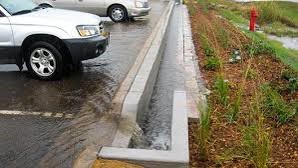Level spreaders
(Redirected from Level spreader)
Jump to navigation
Jump to search

This clever design incorporates a level spreading device after a curb cut has narrowed the flow path. This kind of treatment train approach would provide an opportunity to provide pretreatment at the point of concentration. Photo credit: MPCA
Level spreaders should conform to the following design criteria in order to ensure non-erosive sheet flow into vegetated areas such as vegetated filter strips, bioretention, swales or forested conservation areas[1].
The length of the level spreader should be determined by the design storm inflow rate and type of landscape downstream:
- 1.4 m of level spreader length per every 0.01 m³/s of inflow when draining to a vegetated filter strip, bioretention, swale or grassed area;
- 4.3 m of level spreader length per every 0.01 m³/s of inflow when draining to a forested conservation area.
- The minimum level spreader length is 4 m and the maximum is 40 m.
- The level spreader lip should be concrete, wood or pre-fabricated metal.
- The ends of the level spreader section should be tied back into the slope to avoid overflow scouring or erosion around the ends.
- The width of the level spreader should be the greater of 300 mm or three times the diameter of the inflow pipe.
- The depth should be the greater of 200 mm or half the inflow pipe diameter.
References[edit]
- ↑ Hathaway, J. M., & Hunt, W. F. (2006). Level Spreaders : Overview , Design , and Maintenance.
